Objects and Their Stories
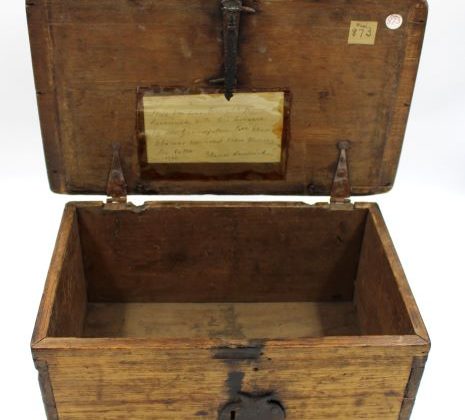
Ditty Box
This is may seem like a rather ordinary object but one which would have been of deep personal importance to the officer it belonged to. It is a ditty box. It’s about the size of a shoebox and would have held a soldier’s precious personal possessions, including letters he received and also the writing paper, ink and pens he would need to write to other people. In time away from family, news of home would have been important to soldiers and it was equally important for a soldier’s family to hear from them.
Our ditty box belonged to a Colonel Shaw, who was part of the 46th of Foot, one of the early regimental ancestors of the Duke of Cornwall’s Light Infantry . He carried it with him, and brought it home, from an expedition with the regiment to Havana, Cuba in 1762. The handwritten label inside the box reads: ‘This box was brought home from Havannah with his treasure by our grandfather Col T. Shaw who was wounded there during the battle 1762, Eleanor Hardwick.‘
It’s unclear exactly what the origin of the name ditty box is. One suggestion is that is comes from the Anglo Saxon word “dite” which means tidy or neat. It has also been suggested that the name is simply a shortening of the word oddity or commodity, which would refer to what the box held. Another theory is that the use of these boxes replaced the use of bags made of “dittis” a type of cotton cloth, and the name held this historic reference.
See the Ditty Box in 3D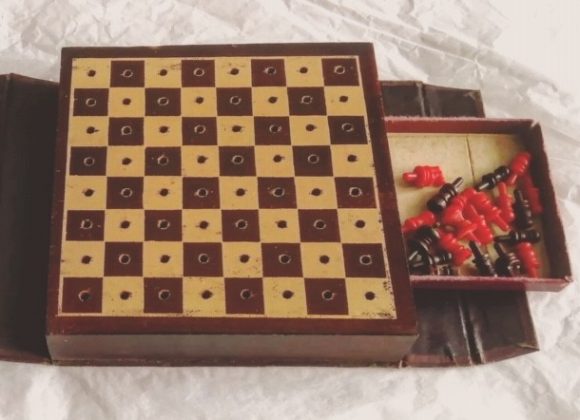
The Tiny Chess Set
In Prisoner of War camps, particularly in WWI and WWII, the prisoners would receive parcel deliveries from The Red Cross. These parcels would have been a very welcome sight, containing food, chocolate, cigarettes and sometimes items to help pass the time and keep the PoWs entertained, like playing cards and games.
A Prisoner of War camp relied heavily on these parcels. They supplemented the overall food supplies on the camp, as all food from the parcels was given to the communal kitchen. The parcels also raised morale and and gave the men something to look forward to and the chocolate or cigarettes would have been a good barter product to trade with guards and prisoners alike!
Patrick Lineham DCLI kindly gifted this tiny chess set to the museum on his the item accepted into the 100th Birthday. The small chess set he once owned whilst a Prisoner of War in Munich in 1945 during WWII.
The chess set was designed by American company, W.M.F. Drueke & Sons. They were designed as ‘pocket’ sets, small and compact enough to be carried by servicemen with their kit, with tiny plastic playing pieces which are contained in a drawer below a small wooden board.
Patrick was given this chess set by a South African Prisoner of War whilst they were both held in captivity. Both Patrick and the chess set survived the Prisoner of War Camp and Patrick has cherished it all this time.
Read More about Private Lineham here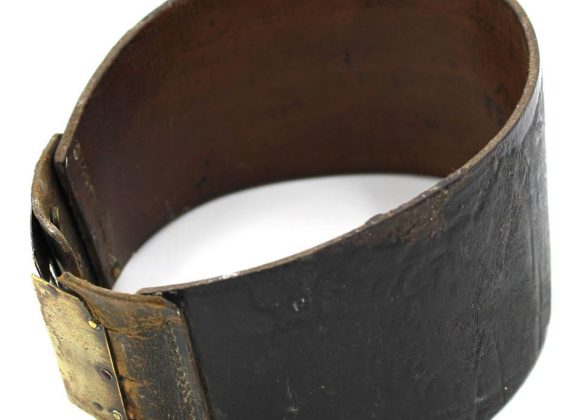
Soldier's Leather Stock
This week’s Object of the Week is a leather ‘Stock’ (a rigid collar) dating from 1837. It was designed for fashion rather than protection and would have been worn under smart dress uniforms in peacetime as well as in combat.
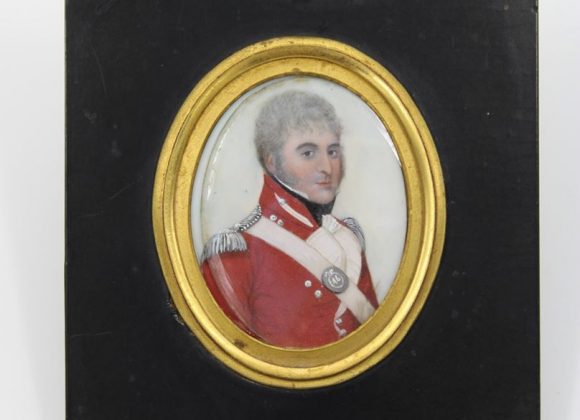
Miniature Portrait
This miniature portrait from our collection, painted around 1800, shows an officer, Edward Mockler of the 46th of Foot regiment, wearing a leather stock under the collar of his coatee. It must have been really uncomfortable and in fact, it was tricky to look down the sight of your musket when wearing one, so they were largely done away with during the Crimean War in the 1850s.

Razor and Case
A razor would have been an integral part of the duty of a soldier. They would have carried their own shaving kit, including a straight razor. This one was owned by a Private J H Hicks of the 32nd of Foot, all soldiers were presented with one when they went to India in 1846, and he carried his with him when he served with the regiment at Lucknow in 1857. The razor is made by a Sheffield company, M. Hunter & Son.
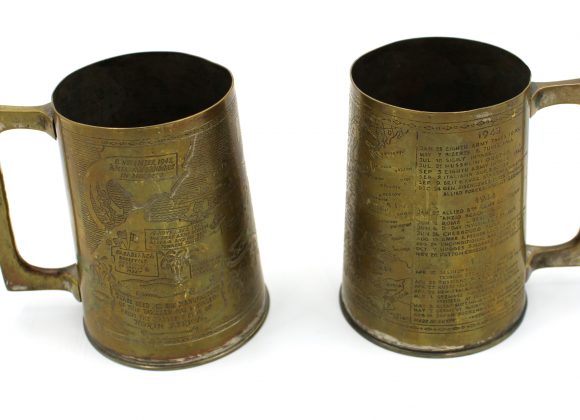
WWII Tankards
These two tankards were most likely made to be decorative rather than to be drunk from. Many people will be familiar with trench art from WWI, made from reused shell and bullet casings. These are in fact made to commemorate WWII and are created from two shell casings. One tankard displays a map of Europe and a timeline of the European conflicts in WWII, and the other shows details of the Western Desert campaigns fought in North Africa.
Ceasing of Hostilities Communication
This communication to the army gives orders for the ceasing of fighting at 0800 on the 5th May and was sent to the 21st Army Group, who were a formation of British military headquarters with responsibility for armies in the field, and their supporting units. When Field Marshal Montgomery accepted the surrender of the German military in the Netherlands, Denmark and north-west Germany, this communication would have been sent out and then the message transmitted to the units of the army in active service. The 5th Battalion DCLI were in Germany when the news was received, too much relief after they had seen little rest from battle for a year.
Bridge Set
This bridge set would have been used by an officer of the Duke of Cornwall’s Light Infantry. The playing cards even have the monogram of the regiment, CLI on the back of them.
Jungle Hat
For Light Infantry soldiers the hat they wore when serving in the jungle was designed to work best for the climate they were in. It was a floppy hat, so sweat came off it (ugh), and had a floppy brim to protect you from sunlight. To protect the soldiers out on patrol it also had a coloured band round it, so that the soldiers back at base could be called to be told what colours to expect back to base.
Dunkirk Flag
On the 1st June 1940, the 2nd Batallion Duke of Cornwall’s Light Infantry (DCLI) were evacuated from the beaches at Dunkirk. Part of Operation Dynamo, the evacuation of British and French soldiers from the beaches came after a targetted attack by the Germans. The order to evacuate was given on the 26th May 1940, and the men of the BEF, as well as thousands of French soldiers, were picked up by many Little Boats. These little boats were pleasure craft from Britain who crisscrossed the channel to evacuate soldiers and bring them home. After the ports along the coast of France were destroyed by the Germans, evacuation from the beaches was necessary, with the Little Ships being able to come closer to shore to pick people up, with larger craft, including Royal Navy vessels, waiting in deeper water to receive soldiers. The mole, the harbour wall at Dunkirk, was also utilised for the evacuation of soldiers by these bigger ships. When the DCLI were rescued, this remarkable Union Flag, almost 3 metres in length, was picked up off the beaches and brought home by a Captain J. Hodgkinson, who had been serving with the DCLI since 1940. Slightly wounded during the evacuation he continued to serve with the armed forces.
WWI Mess Tins
Every soldiers would carry their mess kit with them, this set from WWI contains everything you would need to cook your meal in and eat from it. It includes, two tins (these were both your pans and your bowls for eating from, a plate, salt and pepper shakers, containers for holding food and condiments, and not forgetting your tea strainer! This set belonged to Captain Frederick Marriner Aston, of the 6th Battalion DCLI, he was killed in action in 1915 at the age of 48.
Physical Training (PT) kit
The army had a separate physical training (PT) kit they would wear when they were exercising and training. For the DCLI the physical training kit was white vest and shorts, but by the time of the Light Infantry, they were wearing a red t-shirt and blue shorts.
